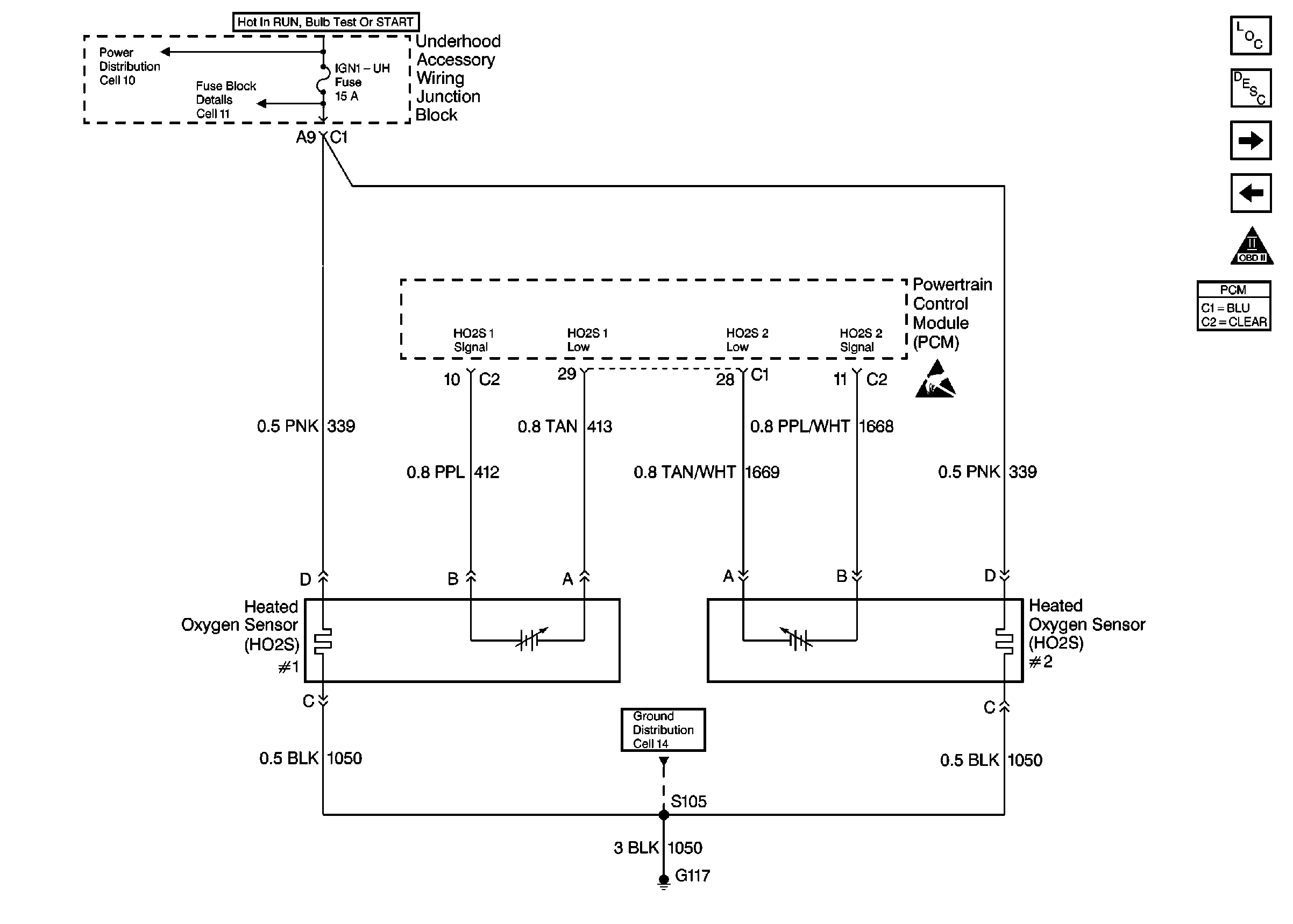Refer to
Cell 20: Engine Data Sensors-HO2S 1, Ho2S 2

.
Circuit Description
The PCM continuously monitors the Heated Oxygen Sensor (HO2S) activity for 100 seconds. During the monitoring period the PCM counts the number of times that a rich to lean and lean to rich response is indicated and adds the amount of time it took to complete all transitions. With this information, an average time for each transition can be determined. If the average response time is too slow, a DTC P0133 will be set.
A lean to rich transition is indicated when the HO2S voltage changes from less than 300 mV to greater than 600 mV. A rich to lean transition is indicated when the HO2S voltage changes from more than 600 mV to less than 300 mV. An HO2S that responds too slowly is likely to be faulty and should be replaced.
Conditions for Running the DTC
| • | No active TP, MAP, MAF, IAT, ECT, or CKP sensor, misfire, fuel injector circuit, EVAP, Fuel trim, EGR, or DTCs present |
| • | Engine has been running in Closed Loop for at least 1 minute |
| • | Engine speed is between 1000 RPM and 3000 RPM |
| • | Engine Coolant Temperature greater than 50°C (122°F) |
| • | EVAP Purge duty cycle less than 35 percent |
Conditions for Setting the DTC
| • | H02S 1 lean to rich average transition response time was longer than 114 milliseconds. |
| • | H02S 1 rich to lean average transition response time was longer than 110 milliseconds. |
Action Taken When the DTC Sets
| • | The PCM illuminates the malfunction indicator lamp (MIL) on the second consecutive ignition cycle that the diagnostic runs and fails. |
| • | The PCM records the operating conditions at the time the diagnostic fails. The first time the diagnostic fails, the PCM stores this information in the Failure Records. If the diagnostic reports a failure on the second consecutive ignition cycle, the PCM records the operating conditions at the time of the failure. |
| • | The PCM writes the conditions to the Freeze Frame and updates the Failure Records. |
Conditions for Clearing the MIL/DTC
| • | The PCM will turn OFF the malfunction indicator lamp (MIL) during the third consecutive trip in which the diagnostic has run and passed. |
| • | The history DTC will clear after 40 consecutive warm-up cycles have occurred without a malfunction. |
| • | The DTC can be cleared by using a scan tool. |
Diagnostic Aids
Check for the following conditions:
Important: : Remove any debris from the connector surfaces before servicing a component. Inspect the connector gaskets when diagnosing or replacing a component. Ensure that the gaskets are installed correctly. The gaskets prevent contaminate intrusion.
| • | Poor terminal connection. |
| Inspect the harness connectors for backed out terminals, improper mating, broken locks, improperly formed or damaged terminals, and faulty terminal to wire connection. Use a corresponding mating terminal to test for proper tension. Refer to Intermittents and Poor Connections Diagnosis , and Connector Repairs Wiring Systems. |
| • | Damaged harness. |
| Inspect the wiring harness for damage. If the harness appears to be OK, observe the sensor display on the scan tool while moving connectors and wiring harnesses related to the sensor. A change in the sensor display may indicate the location of the fault. Refer to Wiring Repairs in Wiring Systems. |
| • | Inspect the PCM and the engine grounds for clean and secure connections. |
If the DTC is determined to be intermittent, reviewing the Fail Records can be useful in determining when the DTC was last set.
Test Description
The numbers below refer to the step numbers on the Diagnostic Table:
-
Verifies that the fault is currently present.
-
HO2S transition time, ratio, and switching DTCs set for multiple sensors indicate probable contamination. Before replacing the sensors, isolate and correct the source of the contamination to avoid damaging the replacement sensors.
Step | Action | Value(s) | Yes | No | ||||||||
|---|---|---|---|---|---|---|---|---|---|---|---|---|
1 | Was the Powertrain On Board Diagnostic (OBD) System Check performed? | -- | ||||||||||
If any DTCs are set, (P1133, P1134), refer to those DTCs before proceeding with this diagnostic chart.
Does scan tool indicate DTC P0133 failed this ignition? | -- | Go to Diagnostic Aids | ||||||||||
Did the scan tool also indicate DTC P1133, P1134, failed this ignition? | -- | |||||||||||
4 |
Was an exhaust leak isolated? | -- | ||||||||||
5 | Visually/physically inspect the following items:
Was a problem found in any of the above areas? | -- | ||||||||||
6 |
Does the scan tool indicate voltage near the specified value? | 450 mV | ||||||||||
7 |
Does scan tool indicate voltage below specified value? | 300 mV | ||||||||||
8 | Replace affected Heated Oxygen Sensors. Refer to Heated Oxygen Sensor Replacement . Important: : Before replacing sensors, the cause of the contamination must be determined
and corrected.
Is the action complete? | -- | -- | |||||||||
9 | Repair condition as necessary. Refer to Wiring Repairs . Is the action complete? | -- | -- | |||||||||
10 | Repair open HO2S 1 low signal circuit or grounded HO2S 1 high signal circuit. Refer to Wiring Repairs . Is the action complete? | -- | -- | |||||||||
11 | Repair open HO2S 1 high signal circuit or faulty PCM connections. Refer to Wiring Repairs . Is the action complete? | -- | -- | |||||||||
12 | Replace HO2S 1. Refer to Heated Oxygen Sensor Replacement . Is the action complete? | -- | -- | |||||||||
13 |
Does scan tool indicate DTC P0133 failed this ignition? | -- | System OK |
